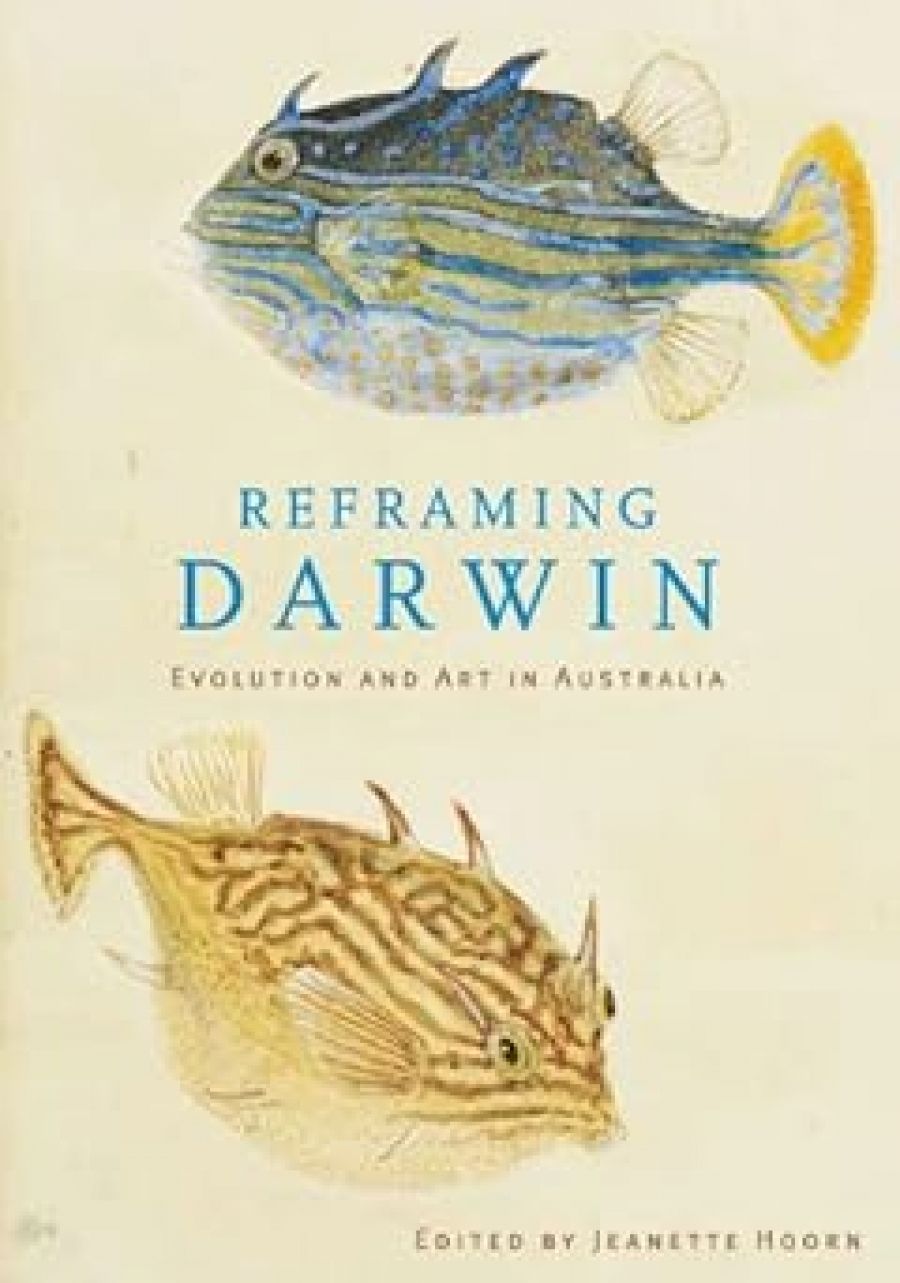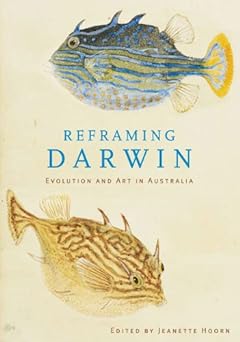
- Free Article: No
- Contents Category: Non-fiction
- Review Article: Yes
- Article Title: Lone Ranger
- Online Only: No
- Custom Highlight Text:
‘The Darwin industry’, now a term with Wikipedia status, refers to the accelerating production of books on Charles Darwin and Darwinian evolution in the last half century. Like any cultural enterprise engaged in mass production and distribution, this industry has its targeted consumers: those who are educated, environmentally concerned, scientifically curious, intelligently sceptical and averse to ‘fundamentalisms’.
- Book 1 Title: Reframing Darwin
- Book 1 Subtitle: Evolution and art in Australia
- Book 1 Biblio: Miegunyah Press, $39.99 pb, 270 pp
- Book 1 Cover Small (400 x 600):

In 2009, the bicentenary of Darwin’s birth and the sesquicentenary of the publication of On the Origin of Species, the industry has spiked dramatically, but the standards of the output are showing some improvement. Many of the new publications are associated with conferences and exhibitions for which extensive scholarly work has been undertaken. Reframing Darwin: Evolution and Art in Australia accompanies an exhibition held at the Ian Potter Museum of Art, in Melbourne. The book is attractively produced, and the range of illustrations is also testament to significant original research.
Of the twelve essays, ten are concerned with highly specific areas of historical enquiry, and each has something to offer in the way of new knowledge. Figures of minor importance, often lost from view in broader treatments of cultural history, come to the fore: the painters Augustus Earle and Conrad Martens, who were present for periods of time with Darwin on the voyage of the Beagle; Syms Covington, Darwin’s servant on that voyage and his ‘unconscious shadow’ for over seven years; a series of French naturalists whose work led in the direction of evolutionary interpretation before Darwin; Baldwin Spencer, appointed foundation Chair of Biology at the University of Melbourne in 1887; and Louisa Anne Meredith, a gifted Australian botanical painter. Aboriginal portraits painted by Tom Roberts are the subject of an incisive reappraisal in Jeanette Hoorn’s study of their relationship to images in Darwin’s Expression of the Emotions in Man and Animals. I also greatly enjoyed Jonathan Smith’s subtle account of John and Elizabeth Gould’s work.
Two further contributions are concerned with current art practices. Barbara Creed writes on the post-Darwinian body in contemporary art, and Alex Taylor analyses the works of contemporary botanical artist John Wolseley, using the lens of historical Darwinism to refreshingly engaged and nuanced effect.
In a collection of such high quality, then, it is disappointing to see some of the old hardcore clichés being paraded, dressed up as revelations. Roger McDonald suggests that the revelatory challenge is ‘imagining ourselves back to a time when the ruling idea was creationist’. ‘Creationist’ is a term that has acquired connotations of determined and consciously programmatic belief that accord with nineteenth-century religious thinking, which had its complexities and pluralities. The Victorian Web lists a range of denominations, with more than a dozen strands of organised dissent and as many alternative and esoteric traditions. Danielle Clode concludes an otherwise scholarly essay with an assertion that ‘Darwin destroyed the pedestal on which humans seek to place themselves’, and Creed states that the theory of natural selection ‘destroyed the belief that a supreme deity had created humankind and placed men and women at the centre of the universe’. The ancient currency of literary metaphors comparing humans to reptiles, mad dogs, rats and hyenas is blithely overlooked in such statements. ‘As flies to wanton boys, are we to the gods,’ says Gloucester in King Lear. How does that figure? John Mulvaney’s essay begins: ‘When, in 1859, Charles Darwin’s Origin of Species extended time and society beyond Eden’s scale and philosophic confines …’ In Principles of Geology (1830), Charles Lyell was already trying to mediate between divines and atheists on this matter, and records his predecessor Hutton’s statement that he ‘can find no traces of a beginning, and no prospect of an end’ in the formative energies of the world. If we are to cultivate a mature and genuinely knowledgeable understanding of Darwin’s influence, it is time to let go of the Lone Ranger mythology.
Exemplary in this regard is Richard Aitken’s fine essay on ‘garden islands’ as laboratories for the evolutionary study of plant species. Aitken’s narrative is backed by a cogent awareness of the relevant intellectual history, which he tracks through references to Linnaeus, Erasmus Darwin, Humboldt, Paley, Lyell, Hooker and Banks. This leads to a focus on how specific points of argument put forward in Darwin’s writings came to be widely influential among the botanical community. Colonial implications are identified. In correspondence with his Australian acquaintances, Darwin was keen to learn about the survival patterns of British and north European perennial plants in South Australia, a question that put his own hypotheses sternly to the test, in that he had repeatedly argued for the superior survival capacities of species modified by human selection and cultivation.
Equally assured in its contextual framing is Ted Gott’s engaging essay on ‘A Gorilla for Melbourne’, which opens with the story of a King Kong precursor: a sculpted gorilla carrying off a struggling female victim, created by Emmanuel Frémiet in 1887 and acquired by the National Gallery of Victoria in 1907. Gott discusses how Frémiet’s sculpture, at once fearsome and deeply pathetic, became a focus for controversies over the nature and origins of the gorilla as a species. The essay explores changing images of the primate, pointing to how the once popular and charming figure of the monkey-man was displaced by the demonic figure of the monster gorilla. Curiously, the more sinister views may have been a variation on a tradition of quite relaxed and humorous anthropomorphism. It was Huxley, according to Gott’s account, who set off the fiercest aspects of the controversy in Melbourne, sparking pro- and anti-Darwin debate in the two leading newspapers.
Far from believing themselves on some kind of cosmic pedestal, many of the most influential mid and late nineteenth-century thinkers were ridden with anxieties about decadence and degeneration, which they projected onto the image of the primate. Advanced contextual work of the kind done by Gott and Aitken enables us to see that ideas of evolution were themselves an evolving phenomenon, extending several generations back from Darwin and continuing variously through and after his period of active contribution.


Comments powered by CComment